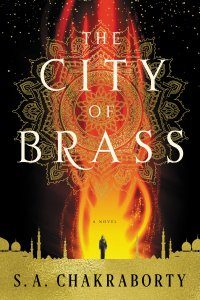Faren Miller Reviews The City of Brass by S.A. Chakraborty
 The City of Brass, S.A. Chakraborty (Harper Voyager 978-0-06-267810-2, $25.99, 535pp, hc) November 2017.
The City of Brass, S.A. Chakraborty (Harper Voyager 978-0-06-267810-2, $25.99, 535pp, hc) November 2017.
The City of Brass by first-novelist S.A. Chakraborty begins a trilogy. Though notably ambitious – taking fantastic elements (and Elementals) from a wide range of Eastern/Middle Eastern myths and folklore and switching between viewpoint characters in two plotlines that converge – it flows with such natural ease, 500-plus pages become swift and compelling. Background emerges from scenes with enough blunt words, unflinching observation, and strong emotion for title city Daevabad, ancient home to long-lived spirits wielding many magics, to feel as gritty and real (troubled amid decaying grandeur) as Cairo during Napoleon’s Egyptian war, where the book opens.
The first three chapters focus on the sly tricks and strangely mounting perils of Nahri, who preys on her “marks” as witch and healer – a role she takes for granted but plays better than she thinks. This scruffy young citizen of Cairo’s slums and markets can speak a tongue nobody else seems to know, understand foreign languages soon as she hears them, and sense the nature of other people’s illness, while her own wounds heal with uncanny speed.
None of this might have changed her life if not for an accidental feat of magic. Planning to con a wealthy Turk out of his house so she can rob it, she uses her “private” tongue for a spell with unexpected consequences. A monstrous entity manifests in a flash, roaring “I will kill whoever called me here!” Her first reaction (italicized like all of Nahri’s unvoiced thoughts): Why is some lunatic fire creature speaking my language? Instead of killing her, the angry djinn saves both of them from wild attacks: first by rival fire spirits who recognize her as a hybrid with links to a famous family of djinn, then by ravening ghouls who drive him to snatch her up and flee, via flying carpet.
Before her plotline moves beyond the vast desert and cursed lake hiding the City of Brass from curious humans, the fourth chapter introduces second viewpoint character Ali, a royal prince of Daevabad who sees the place as natives do. It’s messy, fractious, and threatened by more than one kind of rebel: some from an oppressed underclass of part-human hybrids, others from the city’s original rulers. Since djinn society reflects the world of short-lived mortals with surprising accuracy, unrest can stem from conflicting faiths, tribes, or cultures.
Against this unruly setting, the main narratives unite when Nahri tries to cope with strong, conflicted feelings: attraction to both Dara (the handsome, ancient, near-mythical djinn who first saved her) and her new mentor, Prince Ali. I’ll leave you to discover that fascinating story for yourself.
Faren C. Miller, Contributing Editor, worked full-time for Locus from 1981 to 2000, when she pulled up stakes and moved to Prescott, Arizona (a “mile-high city” not as widely known as that one in Colorado) with the man she subsequently married, Kerry Hanscom. She continues to review SF, fantasy, and horror — enjoying, analyzing, then forgetting all the details on a regular basis — and hopes to keep doing it for many years to come. Author of one fantasy, The Illusionists (Warner 1991), she is working on another which she’s confident will be finished before the next millennium rolls around.
This review and more like it in the December 2017 issue of Locus.



